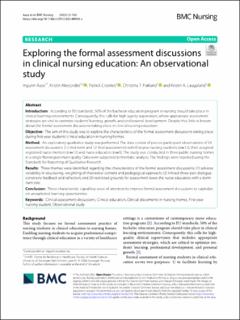Exploring the formal assessment discussions in clinical nursing education: An observational study
Aase, Ingunn; Akerjordet, Kristin; Crookes, Patrick A.; Frøiland, Christina Tølbøl; Laugaland, Kristin Alstveit
Peer reviewed, Journal article
Published version
Permanent lenke
https://hdl.handle.net/11250/3059700Utgivelsesdato
2022Metadata
Vis full innførselSamlinger
Originalversjon
Aase, I., Akerjordet, K., Crookes, P., Frøiland, C. T., & Laugaland, K. A. (2022). Exploring the formal assessment discussions in clinical nursing education: An observational study. BMC nursing, 21(1), 1-10. 10.1186/s12912-022-00934-xSammendrag
Introduction
According to EU standards, 50% of the bachelor education program in nursing should take place in clinical learning environments. Consequently, this calls for high quality supervision, where appropriate assessment strategies are vital to optimize students’ learning, growth, and professional development. Despite this, little is known about the formal assessment discussions taking place in clinical nursing education.
Objective
The aim of this study was to explore the characteristics of the formal assessment discussions taking place during first-year students’ clinical education in nursing homes.
Method
An exploratory qualitative study was performed. The data consist of passive participant observations of 24 assessment discussions (12 mid-term and 12 final assessments) with first-year nursing students (n=12), their assigned registered nurse mentors (n=12) and nurse educators (n=5). The study was conducted in three public nursing homes in a single Norwegian municipality. Data were subjected to thematic analysis. The findings were reported using the Standards for Reporting of Qualitative Research.
Results
Three themes were identified regarding the characteristics of the formal assessment discussions: (1) adverse variability in structuring, weighting of theoretical content and pedagogical approach; (2) limited three-part dialogue constrains feedback and reflection; and (3) restricted grounds for assessment leave the nurse educators with a dominant role.
Conclusion
These characteristic signal key areas of attention to improve formal assessment discussions to capitalize on unexploited learning opportunities.

